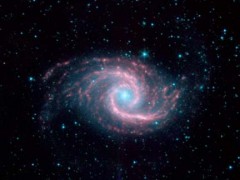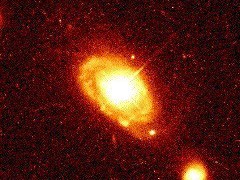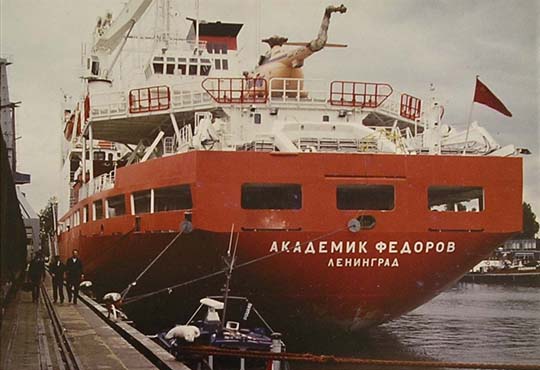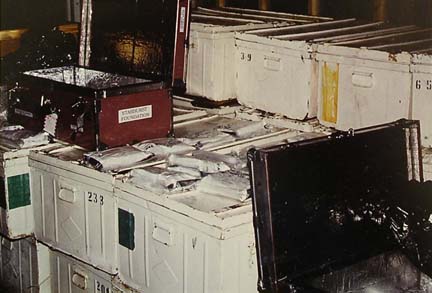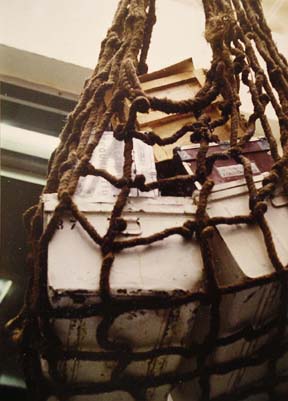Author Archives: luxus
Director's Bio
PAUL A. LaVIOLETTE, PH.D, is author of Secrets of Antigravity Propulsion, Subquantum Kinetics, Earth Under Fire, Genesis of the Cosmos, Decoding the Message of the Pulsars, Galactic Superwaves and their Impact on the Earth, and is editor of A Systems View of Man. He has also published many original papers in physics, astronomy, climatology, systems theory, and psychology. He received his BA in physics from Johns Hopkins, his MBA from the University of Chicago, and PhD from Portland State University. He is currently president and director of the Starburst Foundation.
He has served as a solar energy consultant for the Greek government and also consulted a Fortune 500 company on ways of stimulating innovation. Research he conducted at Harvard School of Public Health led him to invent an improved pulsation dampener for air sampling pumps. Related work led him to develop an improved life-support rebreather apparatus for protection against hazardous environments and for which he received two patents. Dr. LaViolette is the first to predict that high intensity volleys of cosmic ray particles travel directly to our planet from distant sources in our Galaxy, a phenomenon now confirmed by scientific data. He is also the first to discover high concentrations of cosmic dust in Ice Age polar ice, indicating the occurrence of a global cosmic catastrophe in ancient times.
Based on this work, he made predictions about the entry of interstellar dust into the solar system ten years before its confirmation in 1993 by data from the Ulysses spacecraft and by radar observations from New Zealand.
He also originated the glacier wave flood theory that not only provides a reasonable scientific explanation for widespread continental floods, but also presents a credible explanation for the sudden freezing of the arctic mammoths and demise of the Pleistocene mammals. Also he developed a novel theory that links geomagnetic flips to the past occurrence of immense solar flare storm outbursts.He is the developer of subquantum kinetics, a novel approach to microphysics that not only accounts for electric, magnetic, gravitational, and nuclear forces in a unified manner, but also resolves many long-standing problems in physics such as the field singularity problem, the wave-particle dualism, and the field source problem, to mention a few.
Moreover based on the predictions of this theory, he developed an alternative cosmology that effectively replaces the big bang theory. In fact, in 1986, he was the first to cast doubt on the big bang theory by showing that it makes a far poorer fit to existing astronomical data when compared to this new non-expanding universe cosmology.
The subquantum kinetics cosmology also led him to make successful predictions about galaxy evolution that were later verified with the Hubble Space Telescope.Dr. LaViolette is credited with the discovery of the planetary-stellar mass-luminosity relation which demonstrates that the Sun, planets, stars, and supernova explosions are powered by spontaneous energy creation through photon blueshifting. With this relation, he successfully predicted the mass-luminosity ratio of the first brown dwarf to be discovered.More recently, his maser signal blueshifting prediction has found confirmation following publication of the discovery of a blueshift in the Pioneer 10 spacecraft tracking data.
A list of Paul LaViolette's published predictions and their subsequent verification pertaining to his superwave theory and his subquantum kinetics theory.
Letters of support about his research findings.
A list of Paul LaViolette's publications.
Upcoming lectures and radio interviews.
History, Objectives, and Financial Needs
The Starburst Foundation:
History, Objectives, and Financial Needs
Question-Answer Interview of Paul LaViolette,
Ph.D., Director of the Starburst Foundation
January 5, 1988
Steve: When did you first get the idea for the Starburst Foundation?
Paul LaViolette: The Starburst Foundation is a scientific research institute I founded in January of 1984. Its main purpose is to investigate the Galactic superwave phenomenon.
Steve: What are Galactic superwaves, and why do they affect us?
Paul: Galactic superwaves are intense volleys of cosmic rays emitted from the center of our Galaxy. We live in a spiral galaxy, the Milky Way. Our Sun is one of many stars circling around this spiral's hub, the Galactic Center. Astronomers have found that, at this center, there is an unusually massive celestial body that from time to time can explosively emit tremendous amounts of energy. These recurrent explosions (or outbursts) throw out intense barrages of cosmic rays accompanied by electromagnetic radiation such as gamma rays, X-rays, light waves and radio waves. This radiation blizzard, called a "Galactic superwave," travels radially outward eventually reaching the outer part of our Galaxy where we reside.
Superwaves can arrive very unexpectedly. You can't see them coming because they travel towards us at the speed of light. Upon reaching our Solar System a superwave could cause a variety of effects. It could inject cosmic dust into the planetary environs, thereby altering the Earth's climate. Also the electromagnetic wave radiation it carried might at times have the character of an electromagnetic pulse (EMP) similar to that generated by the aerial detonation of a nuclear device. It could create radio and television interference and might knock out satellite telephone conversations by permanently damaging satellite equipment. High-voltage surges picked up on telephone wires and power lines could damage electrical equipment including home electrical and telephone appliances that happened to be plugged into these networks. There could also be dangers to airplanes which happened to be flying during such an episode.
Also there is the possibility that a superwave "EMP" signal might be misconstrued as an aerial nuclear explosion. If military personnel didn't realize that the effects were being produced by an astronomical phenomenon, they might think their country was being attacked and issue orders to launch their missiles. With communication systems knocked out, no one would be able to notify them that their country was not under attack.
Then there may be cause to be concerned about the superwave cosmic rays themselves. If the initial outburst were sufficiently intense, this particle radiation could constitute a substantial health hazard.
The Earth's polar ice sheets preserve a record of past superwave episodes. This can be seen by analyzing the levels of beryllium-10 along the length of the polar ice core record. This beryllium isotope is a good indicator of superwave intensity since it is produced in the Earth's atmosphere through cosmic ray bombardment. The polar record shows several peaks of cosmic ray activity, the most recent of which occurred about 12 - 16 thousand years ago. Additional evidence indicating that our Solar System may periodically be impacted by a forceful cosmic ray wind comes from my discovery that ice age polar ice on some occasions contains very high concentrations of cosmic dust, several orders of magnitude greater than are found in snow or ice from the present interglacial. Prior to this discovery, I had predicted that passing superwaves would have propelled dust into the Solar System and that these dust incursions may have been a principal cause of the recurring sequence of ice ages. This is historically a key discovery because it is the first time that anyone had measured cosmic dust levels for the ice age period.
Purpose
 History has shown that the most significant scientific breakthroughs were not deduced from the existing theoretical framework, but rather arose as marked departures from conventional thinking. Generally such new views challenged long-cherished assumptions espoused by the established paradigm and were therefore actively resisted by the old guard.
History has shown that the most significant scientific breakthroughs were not deduced from the existing theoretical framework, but rather arose as marked departures from conventional thinking. Generally such new views challenged long-cherished assumptions espoused by the established paradigm and were therefore actively resisted by the old guard.
The peer review process, which normally is relied on to determine which ideas out of the many should become funded, is often subject to this bias. As a result, new ideas that could potentially produce scientific breakthroughs are generally refused funding. Thus most work carried out in today's research institutions tends to be traditional, rather than innovative.
The Starburst Foundation was formed to circumvent this problem. It serves as a vehicle through which donors may fund high-quality leading-edge research that otherwise would have great difficulty finding financial support. By greasing the wheels of change, the Starburst Foundation helps to create new concepts and tools nec-essary to mankind's survival in the new age that is now upon us.
Principal Areas of Research
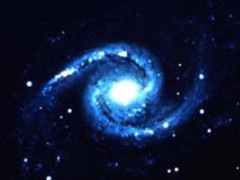 One principal area of Starburst research is concerned with the investigation of Galactic superwaves, intense cosmic ray particle barrages that travel to us from the center of our Galaxy and that can last for periods of up to several thousand years. Astronomical and geological evidence indicates that the last major superwave impacted our solar system around 12,000 to 16,000 years ago and produced abrupt changes of the Earth’s climate. The land mammal extinction episode that occurred during this interval was the worst since the extinction of the dinosaurs. There is a finite chance that one such event could arrive within the next few decades.
One principal area of Starburst research is concerned with the investigation of Galactic superwaves, intense cosmic ray particle barrages that travel to us from the center of our Galaxy and that can last for periods of up to several thousand years. Astronomical and geological evidence indicates that the last major superwave impacted our solar system around 12,000 to 16,000 years ago and produced abrupt changes of the Earth’s climate. The land mammal extinction episode that occurred during this interval was the worst since the extinction of the dinosaurs. There is a finite chance that one such event could arrive within the next few decades.
 Another main area of Starburst research is concerned with the development of subquantum kinetics, a novel microphysics paradigm that incorporates concepts developed in the fields of system theory and nonequilibrium thermodynamics. One of its distinctive features is that it begins at the subquantum level for its point of departure. In choosing an adequate model to represent subquantum process, subquantum kinetics turns to the macroscopic natural world, to our understanding of how certain reaction-diffusion systems spontaneously evolve well-ordered wave patterns.
Another main area of Starburst research is concerned with the development of subquantum kinetics, a novel microphysics paradigm that incorporates concepts developed in the fields of system theory and nonequilibrium thermodynamics. One of its distinctive features is that it begins at the subquantum level for its point of departure. In choosing an adequate model to represent subquantum process, subquantum kinetics turns to the macroscopic natural world, to our understanding of how certain reaction-diffusion systems spontaneously evolve well-ordered wave patterns.
Galactic Cosmic Ray Volleys: A Coming Global Disaster
Galactic Cosmic Ray Volleys:
A Coming Global Disaster
Galactic core outbursts are the most energetic phenomenon taking place in the universe. During the early 60's astronomers began to realize that the massive object that forms the core of a spiral or giant elliptical galaxy periodically becomes active spewing out a fierce barrage of cosmic rays with a total energy output equal to hundreds of thousands of supernova explosions(1, 2). The cosmic ray electron component of such an outburst is always accompanied by synchroton emission which consists of electromagnetic radiation ranging from radio wave frequencies on up to X ray and gamma ray frequencies. A survey has shown that roughly 15% - 20% of all spiral galaxies are currently seen in their active core explosion phase during which they exhibit Seyfert-like characteristics. One example is Seyfert galaxy NGC 1566 (Figure 1). In some galaxies these active emissions have been observed to equal the energy from billions of supernova explosions. The galaxies undergoing these more intense outbursts are sometimes designated as quasars. Their core emission being so strong as to greatly exceed the stellar emission from the galaxy's disc, causing the galaxy to have a star-like or quasi-stellar appearance. One example is the spiral galaxy PG 0052+251 (Figure 2) whose active, quasar-like core is radiating 7 times as much energy as comes from all of the galaxy's stars.
- Figure 1. Image of Seyfert Galaxy NGC 1566, a spiral galaxy whose luminous core is intensely emitting cosmic ray radiation. (Courtesy of NASA/JPL-Caltech/R. Kennicutt (University of Arizona) and the SINGS Team)
-
Figure 2. Image showing the luminous quasar-like core of spiral galaxy PG 0052+25. Taken with the Hubble Space Telescope.
(Courtesy of J. Bahcall and NASA)
During the 70's astronomers realized that the core of our own Galaxy (the Milky Way) has also had a history of recurrent outbursts, that at periodic intervals it enters an active phase in which its rate of cosmic ray emission rises many orders of magnitude.(3) Sometimes designated as Sagittarius A*, the core is estimated to be about 4 million times as massive as our sun; see Figures 3 and 4. But some of the larger more mature galaxies can have core bodies that range up to billions of times the mass of our Sun. Conventional astronomy refers to these as "black holes," visualizing all of the galactic core's mass to be concentrated at a single dimensionless geometrical point. However, evidence suggests that galactic core mass does not exist in the form of a point singularity, but as a very dense supermassive star having a density similar to a neutron star or hyperon star. In the cosmology of subquantum kinetics, these non-singularity core masses are termed mother stars (see link for more information).

Figure 3. Infrared image of the Galactic center radio-emitting source Sagittarius A* seen at a wavelength of 8.7 microns (red spot marked as GC). Taken with the Hale Telescope. (Courtesy of Stolovy, Hayward, and Herter)
Figure 4. Stars orbiting the Galactic center 4 million solar mass Mother Star
(Mapped by the UCLA Galactic Center Group)
Paul LaViolette, who is currently president and chief researcher of the Starburst Foundation, was the first to demonstrate that cosmic rays radiated from the active core of an exploding galaxy can penetrate far outside the galaxy's nucleus to bombard solar systems like our own residing in its peripheral spiral arm disk. He coined the word "galactic superwave" to refer to such a cosmic barrage. Galactic superwaves are a recent discovery. Until recently, astronomers believed galactic cores erupted very infrequently, every 10 to 100 million years.(1) They also believed that interstellar magnetic fields in the Galactic nucleus would trap the emitted particles in spiral orbits causing them to reach the Earth very slowly.(4) For these reasons, most astronomers did not believe that core explosions in the Milky Way posed any immediate threat to the Earth.
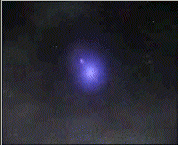
Hypothetical rendition of a Galactic core outburst (from the video Earth Under Fire, courtesy of Gaiam)
However, in 1983 LaViolette presented evidence to the scientific community indicating that:(5 - 7)
• Galactic core explosions actually occur about every 13,000 - 26,000 years for major outbursts and more frequently for lesser events.
• The emitted cosmic rays escape from the core virtually unimpeded. As they travel radially outward through the Galaxy, they form a spherical shell that advances at very close to the speed of light.
Astronomical discoveries subsequently confirmed aspects of this superwave hypothesis; see Verified Prediction No. 2. For example, in 1985, astronomers discovered that Cygnus X-3, an energetic celestial source of cosmic rays, which is about the same distance from Earth as the Galactic Center (25,000 light years), showers the Earth with particles traveling at close to the speed of light, moving along essentially straight paths.(8) Later, scientists found the Earth is impacted, at sporadic intervals, with cosmic rays emitted from the X-ray pulsar Hercules X-1 (about 12,000 light years distant).(9, 10) The intervening interstellar medium has so little effect on these particles, that their pulsation period of 1.2357 seconds, is constant to within 300 microseconds.
Disclaimer: The synopsis of the superwave theory presented here should not be regarded as a complete presentation of this theory for the purpose of scientific debate on the internet.
Those interested in a rigorous presentation of the theory and its supporting evidence should consult the update of Paul LaViolette's Ph.D. dissertation (available in CDROM format) and his various papers some of which are available for download at this website. His book Earth Under Fire is also a good resource but is written for a general audience and is not intended as the primary reference to rely on for scientific debate.
Superwave Predictions
Predictions Part I
astronomy and climatology
Superwave Theory Predictions
and their Subsequent Verification
Galactic Core Explosions - prevailing concept (1980): At the time of this prediction, astronomers believed that the cores of galaxies, including our own, become active ("explode") about every 10 to 100 million years and stay active for about a million years. Since our own Galactic core presently appears quiescent, they believed it would likely remain inactive for many tens of millions of years. Although, in 1977, astronomer Jan Oort cited evidence that our Galactic core has been active within the past 10,000 years.
Subsequent concurrence (1998): In 1988, Dr. Abshier, a UCLA alumnus and also a Starburst Foundation volunteer, visited astronomer Mark Morris in his office to explain to him Dr. LaViolette's Galactic explosion hypothesis. Morris dismissed the idea as having no merit. However, Morris apparently changed his opinion after further observation of the Galactic center because ten years later he was quoted in the November 1998 issue of Discover magazine as saying that the center of our Galaxy explodes about every 10,000 years with these events each lasting 100 years or so.
Cosmic Ray Propagation from active cores - prevailing concept (1980 - 1983): At the time of this prediction, astronomers believed that interstellar magnetic fields entrap cosmic rays released from Galactic core outbursts and slow their outward progress so that they reach the Earth after millions of years in the form of a constant low intensity background radiation. They believed that most of the cosmic rays from a core explosion propagated outward perpendicular to the galaxy's rotational plane in the direction of its poles where the magnetic field alignment was believed to be parallel to their direction of travel and to offer the least resistance.
Verification (1985): Astrophysicists discovered that X-ray pulsars continuously shower the Earth with high-energy cosmic ray particles that have traveled over 25,000 light-years at nearly the speed of light, following straight-line trajectories unaffected by interstellar magnetic fields.
Verification (1997): Astrophysicists detected a strong gamma ray pulse arriving from a galaxy billions of light years away having a redshift of 3.4 (see Prediction No. 13 below). Mainstream media, such as Sky & Telescope magazine, suggested that this gamma ray pulse may be accompanied by a volley of high energy cosmic ray particles travelling at very close to the speed of light along a rectilinear trajectory and that the gamma ray pulse is produced by the radial outward movement of this volley. In effect, they were restating the same Galactic superwave idea that LaViolette had proposed 14 years earlier in the face of stiff resistance from mainstream astronomers.
Verification (2000): Radio astronomers announce at the January 2000 American Astronomical Society meeting that the synchrotron radio emission radiated from the Galactic center (Sgr A*) is circularly polarized. Dr. LaViolette, who was present at the meeting, suggested that the observed circular polarization indicated that cosmic ray electrons were travelling radially away from the Galactic center along straight-line trajectories; see press release. Scientists present at the meeting concurred.
Verification (2014 - 2015): Using NASA's NuSTAR space telescope and ESA's XMM-Newton space telescope, X ray astronomers observe an ionized iron wind moving radially outward in all directions from the active core of galaxy PDS 456 and expanding outward at 30% of the speed of light.
Cosmic Ray Bombardment of the Earth - prevailing concept (1980 - 83): At the time of this prediction, astronomers believed that the background cosmic ray flux has remained constant for millions of years, that intense cosmic ray bombardments occur very infrequently, perhaps every 30 million years, primarily as a result of nearby supernova explosions.
Verification (1987): Glaciologists discovered beryllium-10 isotope peaks in ice age polar ice. These indicated that the cosmic ray flux on the Earth became very high on several occasions during the last ice age, confirming Dr. LaViolette's theory that Galactic superwaves have repeatedly passed through our solar system in geologically recent times.
Cosmic Debris Around Solar System - prevailing concept (1980 - 83): At the time of this prediction, astronomers believed that the solar system resided in a relatively dust free region of space.
Verification (1984): The IRAS satellite team published infrared observations showing that the solar system is surrounded by nearby "cirrus" dust cloud wisps.
Verification (1988): Astronomer H. Aumann's observations suggested that the solar system is surrounded by a dust envelope 500 times denser than previously thought.
Verification (1992 - 95): Telescope observations revealed the presence of the Kuiper belt, a dense population of cometary bodies encircling the solar system, beginning just beyond the orbit of Neptune and extending outward past the heliopause sheath.
Verification (1999): Observations of the influx of interstellar dust particles using the Ulysses spacecraft lead Markus Landgraf and his team of European Space Agency astronomers to conclude that the solar system is surrounded by a ring of orbiting dust that begins just outside the orbit of Saturn.
Cosmic Dust Influx - prevailing concept (1979): At the time of this prediction, astronomers believed that the rate at which cosmic dust particles have been entering the solar system and the Earth's atmosphere has remained constant for millions of years. They believed that the solar system lies in a relatively clean interstellar space environment and hence that there is no need to expect the occurrence of recent cosmic dust incursions.
Verification (1981 - 82): LaViolette was the first to measure the extraterrestrial material content of prehistoric polar ice. Using the neutron activation analysis technique, he found high levels of iridium and nickel in 6 out of the 8 polar ice dust samples (35k to 73k yrs BP), an indication that they contain high levels of cosmic dust. This showed that Galactic superwaves may have affected our solar system in the recent past. In addition, he discovered gold in one 50,000 year old sample, making this the first time gold had been discovered in polar ice.
Verification (1984): The IRAS satellite team reported observations that the zodiacal dust cloud is tilted 3 degrees relative to the ecliptic with ascending and descending ecliptic nodes at 87° and 267°, but failed to draw a conclusion from this finding. LaViolette realized that the nodes are aligned with the Galactic-center-anticenter direction in support of his earlier prediction that interstellar dust has recently entered the solar system from the Galactic center direction. 1987: He published a paper in Earth, Moon, and Planets journal explaining that the orientation of the zodiacal dust cloud nodes indicates that this zodiacal dust recently entered from the direction of the Galactic center.
Verification (April 1993): NASA's Ulysses spacecraft team published observations indicating that interstellar dust is currently entering the solar system from the Galactic center direction (from the direction the interstellar wind blows towards us) and hence that most of the dust outside the asteroid belt is of interstellar origin. Their findings were predicted by LaViolette's 1983 and 1987 publications. One Ulysses team member had received Dr. LaViolette's publications in 1985, but LaViolette's work was not cited.
Verification (1995): Cosmochemists publish observations showing that Helium-3 concentrations in ocean sediments, an indicator of extraterrestrial dust influx, changed by over 3 fold on a 100,000 year cycle between 250,000 and 450,000 years ago.
Verification (1996): The AMOR radar in New Zealand detected a strong flux of interstellar meteoroid particles, measuring 15 to 40 microns in size, entering the solar system from the Galactic center direction.
Verification (2000 - 2005): LaViolette demonstrates that the acid layers found in 15,850 year old Antarctic polar ice vary in magnitude with an eleven year solar cycle period thereby indicating an extraterrestrial origin for this material. This finding is supported by the discovery mentioned below (2003) that interstellar dust influx varies in accordance with solar cycle phase. The finding that this gas influx event heralded a series of warming trends that ended the ice age, implicates cosmic dust and solar activation as the causal agents responsible for terminating glacial cycles.
Verification (2003): Using data obtained from the Ulysses spacecraft, a group of European Space Agency astronomers led by Markus Landgraf discover that the rate of interstellar dust influx increased three fold from 1997 to 2000 with the approach to solar maximum. They theorize a correlation between solar cycle phase and interstellar dust influx rate, with the influx rate being highest at the time of solar maximum. Such a correlation could explain why the Sun could become locked into an active, dust accreting mode during times of superwave passage.
Verification (2004): Glaciologists find that the concentrations of iridium and platinum in submicron sized "meteoritic smoke" particles present in polar ice are two to three times higher during the last ice age.
Verification (2007): A group of scientists, the Younger Dryas Boundary (YDB) group, reports high levels of extraterrestrial indicators (Ir, Ni, cosmic spherules, microtektites, 3He, fullerenes at the 12,950 yrs b2k Alleröd/Younger Dryas boundary layer that overlies extinct megafauna and Clovis artifacts.
Tin in Cosmic Dust - prevailing concept (1981): At the time of this discovery, cosmochemists did not believe that extraterrestrial material could have anomalously high concentrations of heavy metals such as tin, antimony, gold and silver. Abundances higher than those typically found in meteorites were looked on with skepticism and evidence that one's samples had been contaminated.
Verification (Jan. 1984): The tin in the 49 kyrs BP dust sample was found to contain an isotopic anomaly indicating that it was definitely of extraterrestrial origin; see Prediction No. 7.
Indirect support (1989): Cosmochemist F. Rietmeijer published a paper describing the discovery of tin oxide grains inside interplanetary dust particles, with tin abundances much higher than typically found in chondritic meteorites. This helps to substantiate LaViolette's 1983 claim that the solar system contains a dust source enriched in tin which is the source of the tin-rich dust found in polar ice.
Verification (May 2007): A group of cosmochemists report finding high levels of tin (25 - 28%) and copper (1 - 11%) along with ET material indicators platinum and nickel in magnetic separates retrieved from the 12,950 yrs b2k Alleröd/Younger Dryas boundary layer and from Clovis sites. They conclude that the grains bearing these volatile metals are of extraterrestrial origin.
Verification (2014): A group of geologists find particles with high levels of tin averaging 48% by weight in conjunction with high levels of nickel in GISP2 Greenland ice core dust samples that date from the 6th century AD. They conclude that the particles are extraterrestrial and that the dust influx associated with this event caused a significant climatic perturbation for a one to two year period.
Verification (2015): LaViolette carries out energy dispersive X ray analysis at Rensselaer Polytechnic Institute. The 49 kyrs BP dust sample was found to contain tin at an abundance of 49% and lead at an abundance of 8.4%. The average ratio of lead to tin in the sample was found to match closely to the interstellar lead-tin ratio and to deviate widely from the meteoritic lead-tin ratio. This established that the tin-rich particles in this dust had an interstellar origin. Interestingly, both metallic lead and tin are superconducting in interstellar space and this property could explain how they came to be concentrated to such high abundances. Also scanning electron microscope images of the dust particles showed that many of the tin-rich particles were porous aggregates and that one contained hundreds of thousands of nanosphere inclusions, both characteristics indicating the cosmic nature of the particles.
Tin Isotopic Anomaly - state of the art (1981): At the time of this prediction, astronomers speculated that tin found in extraterrestrial material could have isotope ratios different from those of terrestrial tin. But up until that time no tin isotopic anomalies had been reported.
Verification (Jan. 1984): Geochemists at Curtin University (Australia) in collaboration with LaViolette used a mass spectrometry technique to determine the isotopic ratios of an unirradiated portion of the tin-rich dust sample. They found significant isotopic anomalies in four isotopes thereby confirming LaViolette's prediction that the tin dust is of extraterrestrial origin. This marked the first time that tin isotopic anomalies had been discovered.
Superwave Preparedness
Steps that Should be Taken for Superwave Preparedness
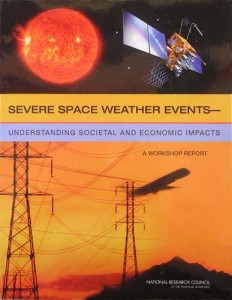 There is an over 90% likelihood that a superwave will arrive in the next 400 years, with a finite chance that one could arrive in the next decade. Currently, radio astronomers are monitoring the cosmic ray synchrotron radiation activity of the Galactic core on a daily basis. They report their findings regularly in IAU (International Astronomical Union) circulars. For the time being the Galactic core appears to be continuing in its quiescent state. However, it is possible that its level of activity could change in the blink of an eye. A superwave might arrive just as suddenly as a gamma ray burst. To prepare for this eventuality, an early warning system needs to be set up and a plan of action needs to be put in place. In this way, should there be signs of a significant core outburst and concomitant superwave cosmic ray arrival, the proper organizations around the world could be promptly notified so that the proper precautions are taken. In this way, the impact of such an event could be drastically reduced.
There is an over 90% likelihood that a superwave will arrive in the next 400 years, with a finite chance that one could arrive in the next decade. Currently, radio astronomers are monitoring the cosmic ray synchrotron radiation activity of the Galactic core on a daily basis. They report their findings regularly in IAU (International Astronomical Union) circulars. For the time being the Galactic core appears to be continuing in its quiescent state. However, it is possible that its level of activity could change in the blink of an eye. A superwave might arrive just as suddenly as a gamma ray burst. To prepare for this eventuality, an early warning system needs to be set up and a plan of action needs to be put in place. In this way, should there be signs of a significant core outburst and concomitant superwave cosmic ray arrival, the proper organizations around the world could be promptly notified so that the proper precautions are taken. In this way, the impact of such an event could be drastically reduced.
More public education is need to increase the general awareness about the phenomenon and its potential threat to the Earth so that ways might be found of minimizing the effects of a superwave should one arrive. More scientific papers need to be presented on research on this subject and media coverage of the subject is needed. Astronomical and geological research needs to be conducted to learn more about this phenomenon. For example, a more detailed analysis needs to be made of the concentrations of beryllium-10 and cosmic dust present in the ice age portion of the Earth's polar ice record which could be remnants of earlier superwave passages.
In regard to the superwave EMP problem, there is a need to develop an awareness about this phenomenon so that if it does occur, nations in possession of nuclear devices do not misinterpret it as an aerial nuclear detonation attack. Also there is a need to develop emergency plans to implement measures that will minimize the impact of a superwave's EMP on power and communications networks. Recently, the U.S. National Research Council made a step in the right direction by publishing a report entitled Severe Space Weather Events: Understanding Societal and Economic Impacts which describes hazards to modern society that could occur should we experience a large magnitude solar storm, similar to the 1859 Carrington event solar flare. The report is relevant from the standpoint of preparedness for a superwave hazard because many of the adverse effects it describes are the same as those that would occur during the arrival of a superwave, even one of relatively low magnitude. The Starburst Foundation had warned the National Research Council and other government agencies about such hazards in their 1989 public outreach project on superwaves. Efforts need to be made to develop and implement user based alternative electrical energy generators so that the factories, hospitals, offices, and residents can disconnect from the electrical power grid. The Starburst Foundation supports efforts to achieve this objective.
Close up of coronal loops over a solar flare made with the TRACE spacecraft in 2005
(courtesy of NASA/TRACE)
Superwave, Essay by Dr. Bloomer
Is Most of Mankind -- and Most Other Life -- Living on Borrowed Time?
GALAXY-WIDE, ALL NATURAL, FOR REAL, NON-FICTIONAL,
ALL-BETS-OFF, IMPENDING COSMIC CRISIS
Essay by Dr. John Bloomer, Ph.D., Aerospace Engineer
Dr. Paul LaViolette is a very quiet, modest, soft-spoken, humble and unassuming, scientist... but like the boy with his finger in the dike, he could be forgiven if he were loud, bombastic, insistent, rude and intemperate - because his message most emphatically means life and death, survival versus oblivion, opportunity grasped over against an accelerating nightmare of the elements of Nature periodically gone wild. The Galactic disaster he alone has discovered and documented, recurs once every 13,000 years. Concatenating astronomy, physics, geology, meteorology and archeology, he finds a ubiquitous, grim and irrefutable true story of stark terror told by astrology, myth and legend: The Core of the Galaxy routinely explodes, leading to circumstances that in the past have resulted in mass extinctions - and we're presently somewhat overdue.
Averting Impending Extinction of Our Civilization by a Recurrent "Superwave" from the Galactic Center
by John H. Bloomer
President, Discraft Corp.
(advanced aerospace science & technology)
1990 S.E. 157th Drive, Portland, Oregon 97233
(503) 251-6914January 2, 1998
To: Fellow-denizens of planet Earth
Ladies & Gentlemen:
Evidently, we face the ultimate survival test for our civilization. Dr. Paul LaViolette has determined that indeed both our species' recent history and that of the crust of our planet, have been both gradual and catastrophic. However, the catastrophes are of first and most immediate concern, since they relate to periodic "superwaves" or volleys of cosmic rays from the Galactic Center itself. The Galactic Center is an incredibly superdense region only about as big as the sphere enclosing Jupiter's orbit: it is about 23,000 light-years away in the constellation of Sagittarius.
Superwaves appear normally to endure for up to hundreds or thousands of years, dating from the time of first arrival of superwave cosmic-ray showers in the Solar System, as shown by recent Russian ice-core samples from the midst of the Continent of Antarctica. As shown by LaViolette, they characteristically, result, in a chain reaction of violent events -- effects which in combination, it appears, can pose a serious hazard to human and most other crustal life on Earth.
Apparently, our civilization -- alike earlier ones -- could be destroyed by such an event, as matters stand, if we don't successfully defend ourselves. When? Evidently unknown. Tomorrow is possible. Or a hundred years from now. Or a thousand. We do seem to be somewhat overdue on an average scale.
It appears that cosmic-ray volleys travel at nearly light speed -- meaning we will have little or no warning, perhaps only minutes, of their imminent arrival. The volley or volleys with our civilization's name on it would already be well on its way from the Galactic Core. From the time a superwave hits, we should have about four months maximum warning before the first of a chain of irreversible worst effects strike -- an effect which inevitably will then precipitate all the others both singly and in combination.
Four months, as matters stand today, would not be nearly enough time to ward off a superwave's progressive, inexorable, devastation of our civilization and our environment (planetary surface):
We need to defend not only our planet, but logically the first line of defense is the Solar System itself. Because superwave-induced changes in the Sun will cause some of the worst damage to the human species unless we avert them by somehow shielding the Solar System. For example, due to drastic, superwave-caused, solar-flare activity increase, central electrical power all over the globe could immediately and permanently be cut off. Solar flares could increase by factors of many hundred times, covering the Sun, as cosmic dust invades the solar system and the Earth's atmosphere, initiating a permanent, everyday, day-long darkness along with great heat from dramatically increased infrared radiation. This heat will initiate great drying, conflagrations, sweeping the planet -- grass, trees, homes and forests will be burned -- while great ocean evaporation proceeds to return as torrential downpours then the snow and ice of a New Ice Age (this in fact seems to be the mechanism initiating Ice Ages -- they begin with, are precipitated by, cosmic dust brought in by Galactic Core superwave volleys). In the heating period preceding the Ice Age, mountain glaciers and the ice caps will undergo drastically increased melting rates, possibly initiating devastating floods.
Clearly drastic advances in the sciences of aeronautics and astronautics are not only desirable, but they are absolutely urgent and imperative.
Reference: Earth Under Fire, by P. A. LaViolette, 1997, 2005 (Bear & Co., Rochester, VT).
Question Regarding the Galactic Center's Current Effects
Answering a Question Regarding the Galactic Center's Current Effects on the Sun and Earth
Paul LaViolette (P. L.) attempts to address some questions below.
From an email he received 1/16/06:
Dr. LaViolette and/or Staff at Starburst Foundation:
Could it be that the solar sunspot activity that peaks every 11 years in our solar system is a reaction to a mini galactic superwave/ripple that hits our solar system at the same time? and if so, could a review of the 11 year sunspot cycles for increases in intensity (over however many sunspot cycles data has been collected) show a trend toward increased likelihood of a big event?
It would seem that if the sun spot activity and output of energy from two or more consecutive 11 year cycle solar events showed an exponential upward curve trend in intensity that the third or fourth following 11 year cycle might be the big one, no?
P. L.: In the past, I had wondered whether the 11 and 22 year solar cycle may be related to long-period gravity potential fluctuations emanating from the Galactic core. The subquantum kinetics physics theory links gravity potential to genic energy production rate, and hence to solar output. That is, about 10 to 15 percent of the solar output is predicted to be of non-nuclear origin arising from photon energy blueshifting. The energy spontaneously generated through photon blueshifting is what I term genic energy. The rate of photon blueshifting and hence of genic energy production is predicted to correlate with the ambient value of the G potential.
More negative gravity potential is predicted to create more supercritical conditions in the reactive ether which in turn increase the rate of photon blueshifting. So in theory cyclic changes in the G potential generated at the Galactic center could produce a cyclic effect on solar luminosity and possibly the level of sunspot activity. But there are no detectors I know of that will measure the ambient value of the gravity potential, particularly levels varying as slowly as 11 years peak to peak.
Gravity wave detectors are of no help since they are designed to measure force, not potential, and forces that vary over short time scales (e.g., minutes).
So it is difficult to test this hypothesis. Also the mother star Sgr A* at the center of the Galaxy has a mass of about 4 million solar masses as compared with 10 billion solar masses for the Galaxy's central bulge. So even a large 50% variation in the mass of Sgr A* would produce only a 0.01% change in the local G potential or a change of one part per million in the Sun's G potential (the Sun's G potential being 50 times larger in magnitude than the Galaxy ambient).
Since genic energy luminosity is about one tenth of the total solar luminosity, one would expect to see a change of only a tenth of a part per million in the Sun's overall luminosity. The Sun's luminosity instead changes by about 0.1% over one solar cycle. So it seems more likely that this solar cycle variation is due to processes intrinsic to the Sun and not to the Galactic center. If there were such a Galactic center effect, one would expect to see subtle cyclic variations in other stars that have a similar 11 and 22 year cycle period. But I don't know that there is any evidence of this.
I don't deny that there are ongoing gravity potential fluctuations coming from the center of the Galaxy that may affect the Earth. As I mention in Earth Under Fire, in the 1970's Dr. Joseph Weber at the University of Maryland claimed to have detected gravity waves with his gravity wave antenna and claimed that they emanated from the direction of the Galactic center. But his results were not believed by the scientific community. Also Townsend Brown reported changes in electro-gravitic force that had a correlation with the orientation of the zenith to the Galactic center.
U.S.-Soviet Antarctic program exchange
Starburst initiates the first U.S.-Soviet
Antarctic base program exchange
In 1987, during the peristroika period, Starburst Foundation researcher Paul LaViolette spearheaded the first US-Soviet ice core exchange. This resulted in closer ties between U.S. and Soviet ice core programs. LaViolette's initial intention was to obtain ice samples from the new deep ice core that had been drilled at the Soviet base in Vostok, Antarctica. Previously there was no way for U.S. researchers to receive samples from the Soviets due to the ongoing cold war. After sending several letters to the Arctic and Antarctic Research Institute in Leningrad (St. Petersburgh), and one letter to the Soviet Embassy in Washington, LaViolette received a letter in May 1987 from the head of the Soviet polar program laboratory agreeing to provide LaViolette with samples and also suggesting that the U.S. and Soviet Union consider an exchange of polar scientists between their two Antarctic bases, Vostok and the Amundsen Scott Station.[1]
The Division of Polar Programs at the National Science Foundation (NSF) had also received a copy of this same letter, but the NSF division director had apparently not responded to the U.S.-Soviet exchange opportunity that was being offered to them, even after having received a June 1st notification call from LaViolette. The Division of Polar Programs did not realize that they had an important opportunity before them until after LaViolette had called up their office a second time in November of that year and pointed out to one of their personnel certain key passages in the Soviet's letter; see telecon transcript.[2] News of this exchange and of LaViolette's trip to pick up the Vostok ice samples was covered the following year in the science section of the Oregonian (June 9, 1988 issue).[3]
Some months later, assisted by funding from a Starburst donor, LaViolette prepared two insulated ice chests and set out to pick up the samples he had been promised. He travelled to Rotterdam, Netherlands where he rendezvoused with the Soviet vessel Akademic Federov on its way back from Antarctica. He loaded the samples in insulated chests cooled with dry ice and gel packs and flew them to an ice core storage facility at the U.S. Geological Society facility in Denver.
- Letter from Dr. Korotkevich, Deputy Director of the Soviet Arctic and Antarctic Research Institute sent to LaViolette and NSF, May 1987.
- Telephone conversation between Paul LaViolette (Starburst Foundation) and Herman Zimmerman of NSF Polar Programs Office, November 4, 1987.
- Hill, Richard "Scientist to test Galaxy theory." Oregonian, June 9, 1988, page E2. Also see follow up: "Theory waiting on ice." Oregonian, November 3, 1988, page D1.

